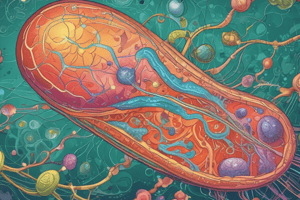Podcast
Questions and Answers
What is the number of ATP produced per glucose molecule in aerobic respiration?
What is the number of ATP produced per glucose molecule in aerobic respiration?
- 40
- 2
- 38 (correct)
- 16
Which type of fermentation do human muscle cells use?
Which type of fermentation do human muscle cells use?
- Lactic Acid Fermentation (correct)
- Krebs Cycle
- Alcoholic Fermentation
- Glycolysis
What is the first stage of both aerobic and anaerobic respiration?
What is the first stage of both aerobic and anaerobic respiration?
- Fermentation
- Krebs Cycle
- Electron Transport Chain
- Glycolysis (correct)
What is the primary difference between aerobic and anaerobic respiration?
What is the primary difference between aerobic and anaerobic respiration?
What is the byproduct of lactic acid fermentation in muscle cells?
What is the byproduct of lactic acid fermentation in muscle cells?
What is the energy efficiency of aerobic respiration compared to anaerobic respiration?
What is the energy efficiency of aerobic respiration compared to anaerobic respiration?
What is the stage at which pyruvate is changed to continue producing ATP in fermentation?
What is the stage at which pyruvate is changed to continue producing ATP in fermentation?
What is the number of ATP produced per glucose molecule in anaerobic respiration?
What is the number of ATP produced per glucose molecule in anaerobic respiration?
What type of cells can continue to produce ATP when oxygen is low?
What type of cells can continue to produce ATP when oxygen is low?
What are the two types of fermentation?
What are the two types of fermentation?
Flashcards are hidden until you start studying
Study Notes
Cellular Respiration
- Cellular respiration is a chemical process that releases energy from organic compounds (food), converting it into energy stored in ATP molecules.
Breathing versus Cellular Respiration
- Breathing is a physical process that allows animals and humans to come into contact with gases in the air.
- Cellular respiration is a chemical process that releases energy from food, converting it into energy stored in ATP molecules.
Chemical Pathways
- Cells use food to synthesize new molecules to carry out life processes.
- Cells do not burn glucose; they slowly release energy from it and other food compounds through several pathways.
Overview of Cellular Respiration
- In the presence of oxygen, glycolysis is followed by the Krebs cycle and electron transport chain.
- The three stages combined make up cellular respiration, releasing energy by breaking down food molecules in the presence of oxygen.
- The equation for cellular respiration is: 6O2 + C6H12O6 → 6CO2 + 6H2O + energy (ATP).
Glycolysis
- Glycolysis is the first stage of cellular respiration, releasing a small amount of energy (2 net ATP).
- If oxygen is present, glycolysis leads to the Krebs cycle and electron transport chain; if oxygen is absent, it leads to fermentation.
Mitochondria
- Mitochondria have three compartments: intermembrane space, cristae space, and matrix.
- They play a crucial role in aerobic respiration.
Aerobic Respiration: The Krebs Cycle and Electron Transport
- The Krebs cycle is the second stage of cellular respiration, breaking down pyruvic acid into carbon dioxide in a series of energy-extracting reactions.
- The Krebs cycle requires oxygen and produces ATP, NADH, and FADH2.
- Electron transport uses the high-energy electrons from NADH and FADH2 to produce a large amount of ATP.
Fermentation
- Fermentation is an anaerobic process that occurs in the absence of oxygen.
- There are two types of fermentation: alcoholic fermentation and lactic acid fermentation.
- Lactic acid fermentation is used by humans.
Comparison of Aerobic and Anaerobic Respiration
- Aerobic respiration is far more energy-efficient than anaerobic respiration.
- Aerobic processes produce up to 38 ATP per glucose, while anaerobic processes yield only 2 ATP per glucose.
Studying That Suits You
Use AI to generate personalized quizzes and flashcards to suit your learning preferences.




